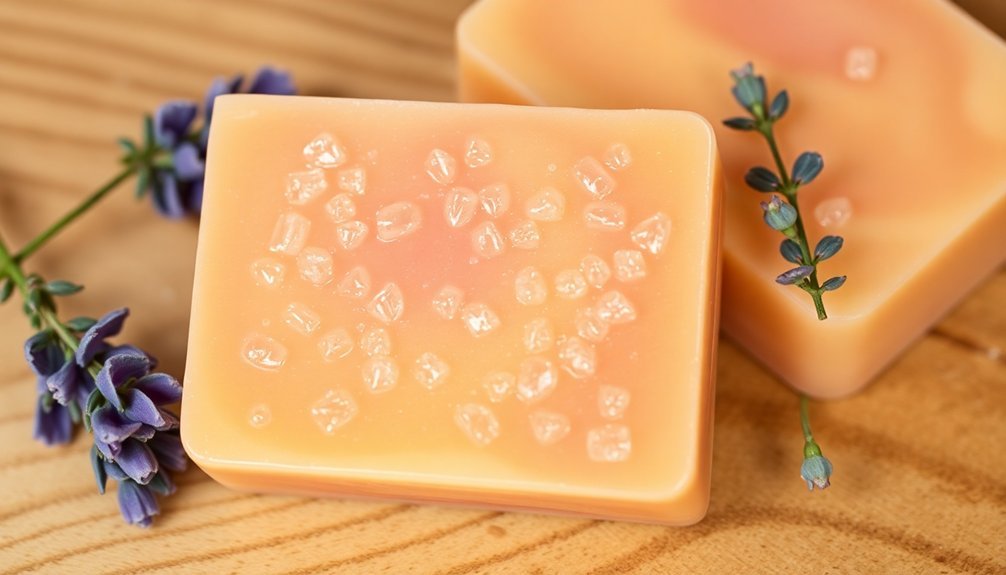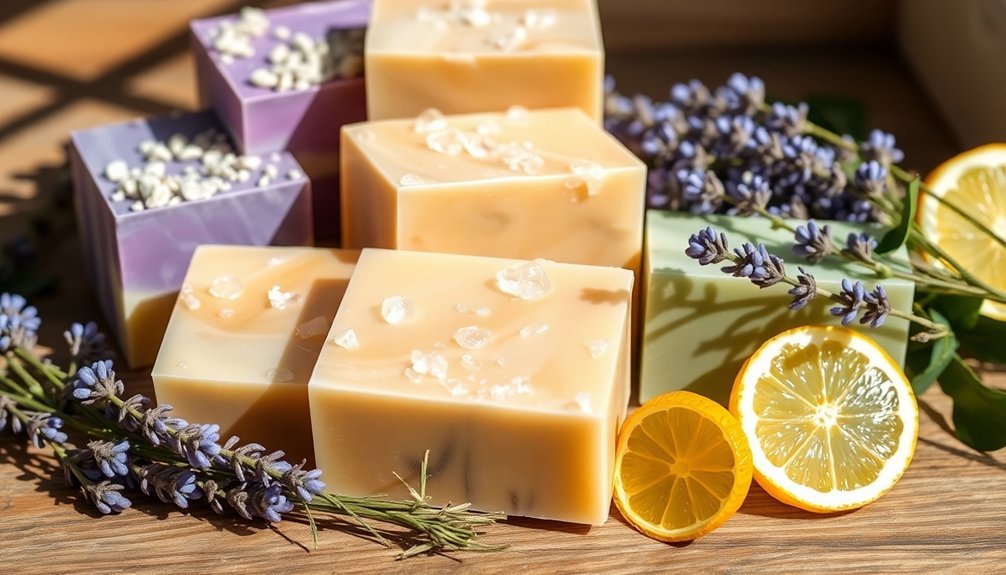To make natural soap with jojoba beads, choose either melt and pour or cold process methods. For melt and pour, add beads when the base cools to 125°F; for cold process, incorporate at medium trace. Use a 2:1 ratio for complementary fragrances and natural colorants like indigo or turmeric. Stir gently to prevent bead damage and guarantee even distribution. These biodegradable beads offer gentle exfoliation without harming waterways. Discover how these techniques create spa-quality results at home.
Why Jojoba Beads Are Superior to Plastic Microbeads

While many consumers have embraced exfoliating products in their skincare routines, not all exfoliants are created equal. Jojoba beads offer a natural alternative derived from jojoba plant wax, unlike plastic microbeads that harm the environment.
You'll find jojoba beads fully biodegradable, sparing our waterways from the pollution plastic microbeads cause. These gentle spheres can't be filtered by wastewater treatment plants, which is why many countries have banned plastic versions. Studies have shown that nearly 75% of treated water in New York contained microbeads, highlighting the severity of this pollution problem.
For your skin, jojoba beads provide gentle exfoliation with their smooth, rounded edges that won't tear delicate tissue. They simultaneously moisturize while removing dead skin cells, maintaining your skin's natural pH balance.
Even if you have sensitive skin, you'll appreciate their effectiveness without irritation.
Essential Ingredients for Jojoba Bead Soap Formulations
Creating exceptional jojoba bead soap requires carefully selected ingredients that work in harmony to deliver both cleansing and exfoliating benefits.
You'll need a quality soap base—either melt and pour or cold process—as your foundation. The star ingredient, jojoba beads, provides gentle exfoliation while adding colorful visual appeal. Choosing jojoba beads offers a significant environmental advantage as they are biodegradable alternatives to harmful microbeads.
For moisturizing properties, incorporate oils like coconut, olive, and jojoba itself. Shea butter enhances the soap's nourishing qualities.
Add fragrance through essential oils like lavender or tea tree, or opt for phthalate-free fragrance oils for unique scents.
Optional colorants such as mica or soap dyes can make your creations visually striking.
Don't forget practical considerations like temperature control during production—you'll want to avoid overheating those precious jojoba beads during the soap-making process.
Step-By-Step Cold Process Method With Jojoba Beads

The cold process method offers soap makers complete control over ingredients while producing a luxurious product that showcases jojoba beads perfectly.
Begin by preparing your lye solution in a well-ventilated area, wearing protective gear. While it cools to 100-130°F, heat your oils to the same temperature range.
Once both mixtures reach the target temperature, slowly pour the lye solution into your oils. Use a stick blender until you achieve a light trace—when the mixture leaves a faint trail on the surface.
At this point, add your essential oils for fragrance.
When the soap reaches medium trace, gently fold in 1/4 to 1/2 teaspoon of jojoba beads per pound of soap. Unlike plastic microbeads, these biodegradable alternatives are environmentally friendly while still providing effective exfoliation.
Pour carefully into prepared molds, and allow your soap to cure for several weeks before using.
Melt and Pour Techniques for Quick Jojoba Scrub Soaps
Melt and pour soap making offers four distinct advantages for crafters who want to create jojoba bead scrubs without the complexity of working with lye.
You'll enjoy faster production since these soaps require no curing time after cooling. The premade bases already contain glycerin and nourishing oils, providing a moisturizing experience right away.
For best results with jojoba beads, wait until your melted soap base cools to below 140°F before adding them. Pour at 120-125°F to guarantee even distribution throughout your soap. Using transparent bases will allow your jojoba beads to create a striking shimmer effect visible throughout the bar.
Select from clear bases for vibrant colors or white bases for more subtle, pastel effects. While swirling can be challenging with this method, you'll appreciate the safety benefits and quick results—perfect for beginners or those seeking immediate gratification.
Choosing the Right Colors and Scents for Your Natural Soap

When crafting seasonal soaps, pair spring's soft greens with crisp mint scents, summer's vibrant blues with invigorating ocean fragrances, autumn's warm oranges with spicy cinnamon, and winter's deep purples with comforting vanilla.
For effective fragrance blending, start with just two complementary scents at a 2:1 ratio, such as lavender and chamomile or citrus and mint, before experimenting with more complex combinations. To enhance purple hues in winter soaps, consider using Ratanjot or Alkanet as natural colorants that produce beautiful purple tones.
You'll create more appealing jojoba bead scrub soaps by coordinating your colors and scents to evoke specific moods or seasons, keeping in mind that some essential oils can affect natural colorants.
Seasonal Color Pairings
Selecting seasonal color pairings for your natural jojoba bead soaps creates products that resonate with customers' moods throughout the year.
For winter holidays, pair traditional red and green complementary colors with your jojoba beads. These classic combinations work perfectly because they're opposites on the color wheel.
Spring soaps shine with pastel color schemes or vibrant greens that evoke renewal.
Summer calls for bright yellows, oranges, and blues that reflect sunshine and clear skies. These warm and cool tones create striking visual effects when combined thoughtfully in your soap designs.
When autumn arrives, incorporate earthy oranges, reds, and yellows reminiscent of falling leaves.
For maximum visual impact, consider using contrasting colors like darker and lighter blues in layers. You can also create depth with monochromatic gradations.
Remember to choose only safe, soap-appropriate colorants—natural options like indigo, turmeric, and activated charcoal offer beautiful results while maintaining your soap's natural integrity.
Fragrance Blending Tips
Creating harmonious fragrance and color combinations for your jojoba bead soaps involves understanding the relationship between scent and visual appeal.
When blending fragrances, start with small amounts and adjust gradually to achieve your desired scent profile. Remember that stronger oils should be used sparingly to avoid overwhelming other notes. Consider using a liquid discount technique to help retain more of your fragrance during the curing process.
For successful fragrance blending in your jojoba bead soaps:
- Mix kaolin clay with your fragrance oils to anchor scents, using 1-2 tablespoons per pound of soap oils.
- Document your blend ratios (like 2:1 vanilla to lavender) for consistency in future batches.
- Match colors to your fragrance profile—earthy tones for woodsy scents, vibrant hues for fruity blends.
- Test small batches before committing to larger productions, especially when creating custom blends.
Tips for Even Distribution of Jojoba Beads Throughout Soap
Achieving even distribution of jojoba beads throughout your soap requires careful attention to temperature and technique. For melt and pour soap, maintain temperatures between 120-125°F and use a slightly thickened base to prevent beads from floating. In cold process soap, add beads after reaching trace and stir gently to maintain uniformity.
| Soap Type | Temperature | Mixing Technique |
|---|---|---|
| Melt & Pour | 120-125°F | Gentle spatula folding |
| Cold Process | Post-trace | Hand mixing only |
| Whipped | Cooled, airy | Hand mixer on low |
| Foaming Butter | Room temp | Fold with spatula |
| Sensitive Skin | Below 125°F | Minimal stirring |
Whipped soap bases work exceptionally well for even distribution as their fluffy texture suspends beads naturally. For any base, avoid overheating which can melt beads and compromise your exfoliating properties.
Troubleshooting Common Issues When Working With Natural Exfoliants

Even with careful preparation, soapmakers often encounter challenges when incorporating natural exfoliants like jojoba beads into their creations.
Understanding how to troubleshoot these issues will help you create professional-quality exfoliating soaps consistently.
1. Clumping and Uneven Distribution – Add jojoba beads at light trace and stir gently to prevent clumping. Fine exfoliants need to be properly dispersed in lightweight oil or distilled water before adding to your soap mixture to ensure even distribution.
Overmixing can cause beads to cluster in certain areas.
2. Damaged Exfoliants – Handle beads delicately during incorporation to maintain their shape and effectiveness as exfoliants.
3. Poor Layer Adhesion – When working with melt-and-pour, spray rubbing alcohol between layers to guarantee proper bonding and prevent separation.
4. Lather Inhibition – Use exfoliants sparingly, as too many can considerably reduce your soap's ability to lather effectively.
Creative Packaging Ideas for Handcrafted Jojoba Bead Soaps
The perfect packaging elevates your jojoba bead soaps from simple bath products to coveted luxury items.
For eco-conscious presentation, consider organic cotton organza bags or recycled cardboard boxes tied with natural jute twine.
Showcase the textured beauty of your jojoba bead soaps in glassine wax paper bags or wrap them in botanical-patterned paper for visual appeal.
Metal tins offer durability for travel while wooden soap dishes provide both functionality and elegance.
For gift-worthy presentation, create multi-soap sets in custom-bottomed boxes garnished with fresh rosemary or lavender. Enhance the seasonal appeal by incorporating themed packaging elements that complement both the occasion and the soap's fragrance profile.
Don't forget to reinforce your brand with personalized labels or paper bands featuring your logo.
The visible texture of jojoba beads deserves packaging that highlights this unique feature while protecting your handcrafted creation.
Frequently Asked Questions
How Long Do Jojoba Beads Retain Their Shape in Stored Soap?
Jojoba beads retain their shape for 2-3 years in your properly stored soap. You'll find they're stable as long as you maintain temperatures between 10-25°C and protect them from direct light and humidity.
Can Jojoba Beads Be Added to Hot Process Soap Methods?
Yes, you can add jojoba beads to hot process soap. Just wait until the soap cools below 180°F before mixing them in to prevent melting. They'll maintain their exfoliating properties in your finished bars.
Are Jojoba Beads Suitable for Facial Soaps or Body Only?
Jojoba beads are ideal for both facial and body soaps. For your face, they provide gentle exfoliation with rounded edges that won't cause microtears. They're suitable for sensitive skin and environmentally friendly too.
Do Jojoba Beads Affect Soap Shelf Life or Curing Time?
Jojoba beads don't affect your soap's curing time, which depends on the soap base itself. They won't reduce shelf life either, but you'll want to store your finished soap properly for maximum longevity.
Can I Create Custom-Colored Jojoba Beads at Home?
While it's possible to create custom-colored jojoba beads at home, you'll face challenges with pigment solubility and color distribution. You're better off purchasing pre-colored beads or ordering custom colors from specialty suppliers.
In Summary
You've now mastered the art of making natural jojoba bead soaps! They're environmentally friendly, gentle on skin, and fully customizable to your preferences. Whether you've chosen cold process or melt-and-pour, your handcrafted scrubs offer exfoliation without harsh effects. Remember to store your creations properly and gift them with creative packaging. With practice, you'll consistently create beautiful, effective soaps that you'll be proud to use and share.





Leave a Reply